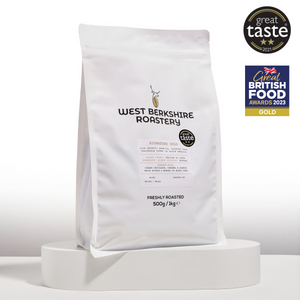Peruvian Coffee: Deep Dive
THE GEOGRAPHY
Peru positions itself slightly outside the global top ten in coffee production, with its annual output roughly amounting to 4 million bags, or 240,000 metric tons. While its production might seem minimal compared to the colossal volumes from neighbouring Brazil and Colombia, Peru holds the title of the premier exporter for organic and high-quality fair trade coffee. It is celebrated globally for producing some of the finest specialty coffees, noted for their smoothness, balance, and fruity notes.
Geographically, Peru is vast, spanning around 500,000 square miles, equivalent to the size of South Africa or double the size of Texas. It is bordered by the South Pacific to the west, Ecuador to the north, Chile to the south, and Brazil and Bolivia to the east. Positioned just south of the Equator, with the Andes as a backdrop and enjoying ample rainfall, high humidity, and the cooling winds from the Pacific, Peru's environment is perfectly suited for coffee cultivation within this broad growing belt.
The country is divided into four principal regions: the rainforest or "selva," covering half of the nation including the Amazon and Madre de Dios river basins; the "sierra" or Andean highlands, home to some of the planet's tallest mountains; the Ceja de Montana, a jungle strip along the eastern Andes slopes; and a vast coastal desert.
Coffee cultivation in Peru primarily spans three regions - Cajamarca in the north, the central Chanchamayo Valley, and Cuzco in the south, thriving at elevations between 1,000 and 1,800 meters. The Arabica bean, particularly the Typica variety, dominates Peru's coffee production.
THE HISTORY OF PERUVIAN COFFEE
It is believed that coffee first made its way to Peru in the 18th century, likely introduced from the Caribbean.
The 20th century saw significant European investment, particularly from Britain, which turned coffee farming into a significant export-oriented industry through the establishment of large-scale plantations.
This industrial approach greatly enhanced the efficiency of coffee bean cultivation and harvesting.
However, the post-World War II period saw the divesture of British holdings and the division of these large estates among numerous small-scale farmers.
Presently, Peru is home to approximately 150,000 coffee producers, each typically managing a farm no larger than 3 hectares (around 7.4 acres).
The terraced farming practised by many, along with the small operation size and challenging topography, complicates the transportation of their harvest to processing facilities or markets.
The situation was made even worse by a devastating leaf rust outbreak in 2014. Despite these challenges, a significant number of Peruvian coffee farmers, about one-third, have joined forces in cooperatives.
The majority of Peru's coffee, which brings in $600 million annually in exports, is shade-grown.
While Peruvian coffee, known for its light body and mild acidity, was traditionally blended with beans from other Latin American countries, there's a growing trend amongst farmers towards producing high-quality speciality and often organic coffees, many of which are also shade-grown.
COFFEE PRODUCTION
Coffee beans from Peru are gathered between May and September. Post-harvest, they are transported to processing stations where they go through wet-washing, either manually or via machinery. Notably, Peru's coffee farms are considered top-tier producers of organic, Rainforest Alliance, and UTZ certified coffees. Not limited to the Typica variant, these farms also cultivate Bourbon, Catua, and Pache.
The enormity of Peru, coupled with its diverse landscape and micro-climates, lends itself to a broad array of coffee growth areas. The concept is similar to how unique grape species yield distinct wines, contingent on the terrain and weather conditions - Peruvian coffee growers house beans distinctive to their particular regions.
To exemplify, farmers of the northern Cajamarca region grow Bourbon, Caturra, and Typica, which coffee enthusiasts acclaim to bear sweet, fruity, and acidic notes. Adjacent Cutervo is known for its Bourbon, Pache, and Catimor beans, presumed to carry vanilla and peach undertones.
The coffee-growing Huanaco zone surrounds Lima, reaching up to elevations of 2,000 meters (approximately 6,500 feet). This lush, fertile area, the pioneer in commercial coffee farming in Peru, is also the nation's most rain-dense coffee-producing locale. The Typica, Caturra, and Catimor beans here are characterized by their sweetness and hints of orange and caramel. Nearby regions, Amazonas and San Martin, collectively account for about 40 percent of Peru's coffee yield. Chanchamayo and Satipo, located further south, are recognized for their coffees' powerful acidity, dark fruit flavours, and creamy mouthfeel.
Southern Peru is assessed to cultivate the nation's finest coffee. Although not a large-scale producer, Cuzco is acknowledged for yielding the highest quality of Bourbon, Caturra, and Typica, owing to the rich soil and local climate.
Bordering Bolivia is Puno, known for securing the 2018 Cup of Excellence. Mimicking Cuzco, Puno prioritizes quality over quantity, growing primarily the same bean types. If bright, vibrant coffee is your preference, Puno's blend is an excellent choice. Described by tasters as a complex, floral, juicy brew, the coffee hints at sweet pineapple, tropical fruits, and chocolate flavours.


